Business Law Report: UK Legal System, ADR, and Case Analysis
VerifiedAdded on 2020/10/22
|14
|3728
|487
Report
AI Summary
This report provides a comprehensive overview of business law, focusing on the English legal system, alternative dispute resolution (ADR), and a case study involving the Consumer Rights Act 2015. Part A details the structure of the UK legal system, differentiating between civil and criminal law, and exploring various sources of law. It also explains ADR methods like negotiation, mediation, and arbitration, highlighting their advantages over traditional litigation. Part B analyzes a case scenario where a homeowner, Paul, purchases bricks for a new holiday home, and faces issues due to the bricks' unsuitability for the construction site. The report identifies the legal issues, applies contract law principles, and discusses the remedies available under the Consumer Rights Act 2015. The report emphasizes the importance of understanding contractual obligations and the implications of product suitability in business transactions.
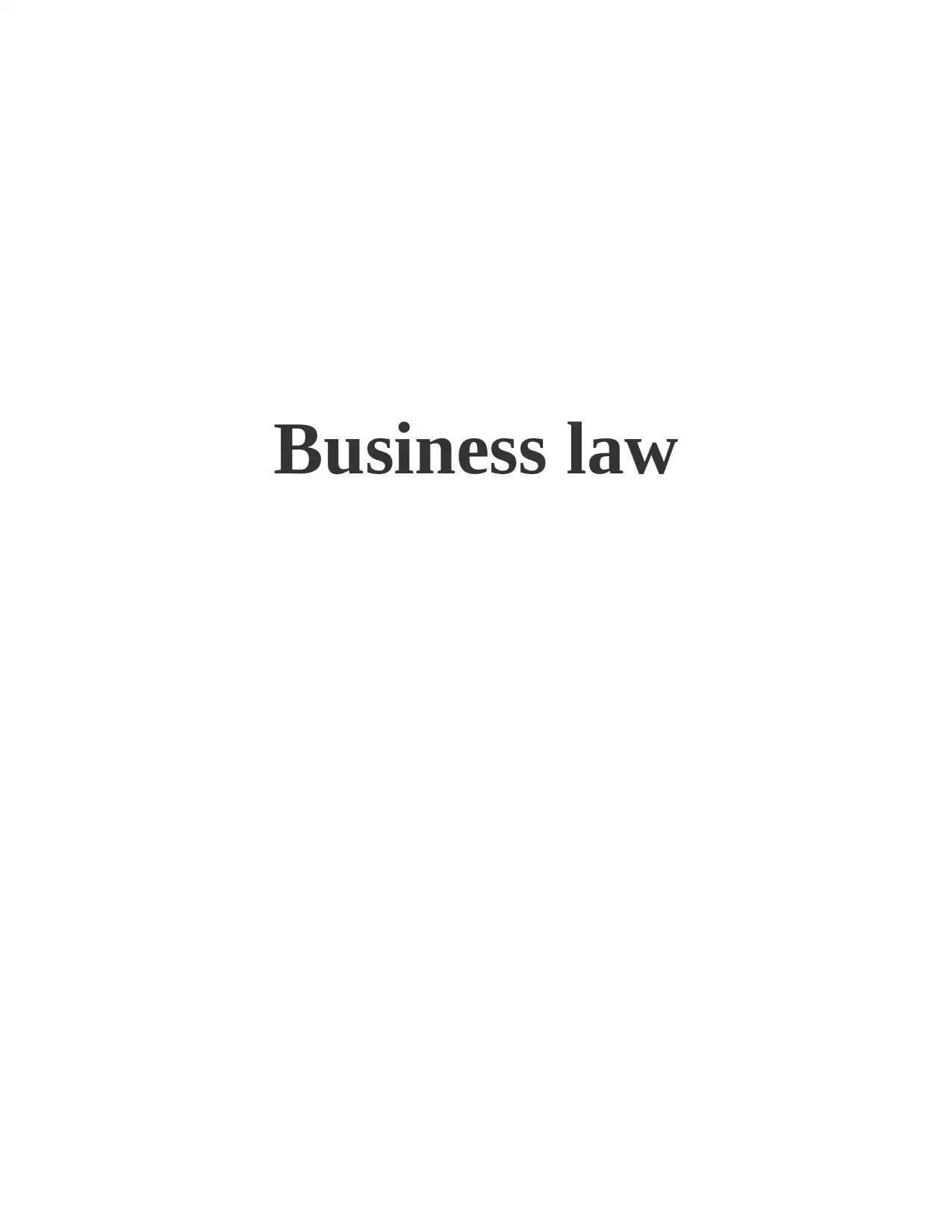
Business law
Secure Best Marks with AI Grader
Need help grading? Try our AI Grader for instant feedback on your assignments.
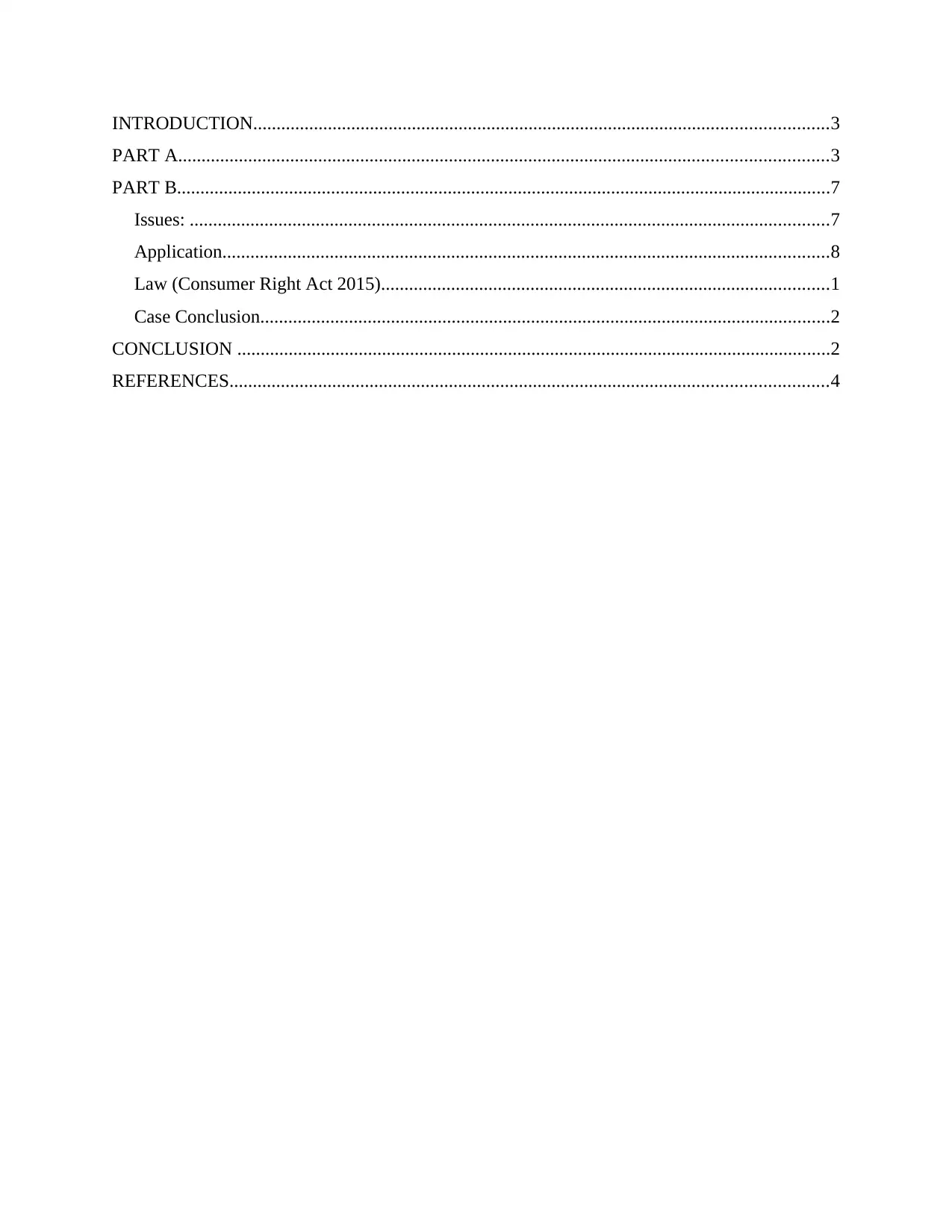
INTRODUCTION...........................................................................................................................3
PART A...........................................................................................................................................3
PART B............................................................................................................................................7
Issues: .........................................................................................................................................7
Application..................................................................................................................................8
Law (Consumer Right Act 2015)................................................................................................1
Case Conclusion..........................................................................................................................2
CONCLUSION ...............................................................................................................................2
REFERENCES................................................................................................................................4
PART A...........................................................................................................................................3
PART B............................................................................................................................................7
Issues: .........................................................................................................................................7
Application..................................................................................................................................8
Law (Consumer Right Act 2015)................................................................................................1
Case Conclusion..........................................................................................................................2
CONCLUSION ...............................................................................................................................2
REFERENCES................................................................................................................................4
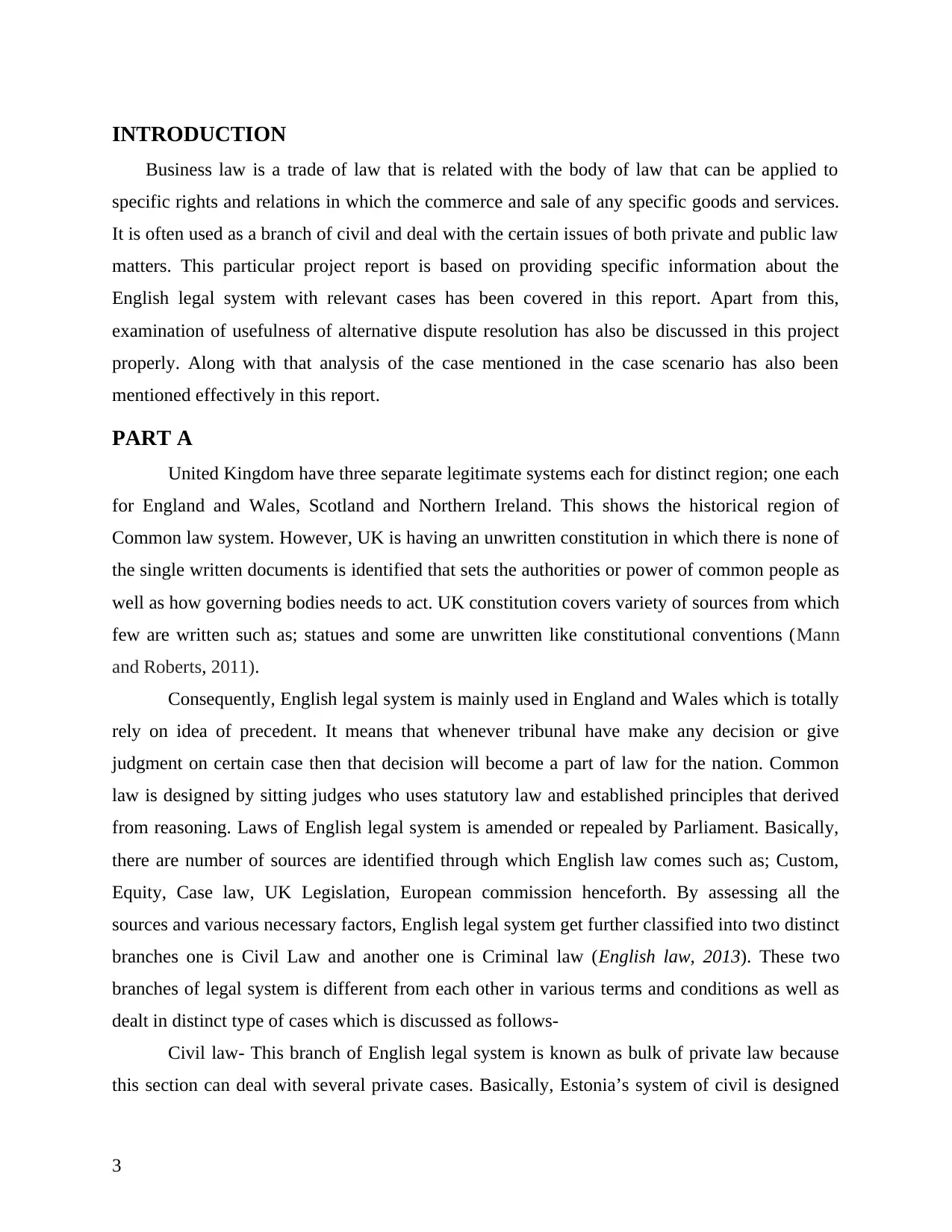
INTRODUCTION
Business law is a trade of law that is related with the body of law that can be applied to
specific rights and relations in which the commerce and sale of any specific goods and services.
It is often used as a branch of civil and deal with the certain issues of both private and public law
matters. This particular project report is based on providing specific information about the
English legal system with relevant cases has been covered in this report. Apart from this,
examination of usefulness of alternative dispute resolution has also be discussed in this project
properly. Along with that analysis of the case mentioned in the case scenario has also been
mentioned effectively in this report.
PART A
United Kingdom have three separate legitimate systems each for distinct region; one each
for England and Wales, Scotland and Northern Ireland. This shows the historical region of
Common law system. However, UK is having an unwritten constitution in which there is none of
the single written documents is identified that sets the authorities or power of common people as
well as how governing bodies needs to act. UK constitution covers variety of sources from which
few are written such as; statues and some are unwritten like constitutional conventions (Mann
and Roberts, 2011).
Consequently, English legal system is mainly used in England and Wales which is totally
rely on idea of precedent. It means that whenever tribunal have make any decision or give
judgment on certain case then that decision will become a part of law for the nation. Common
law is designed by sitting judges who uses statutory law and established principles that derived
from reasoning. Laws of English legal system is amended or repealed by Parliament. Basically,
there are number of sources are identified through which English law comes such as; Custom,
Equity, Case law, UK Legislation, European commission henceforth. By assessing all the
sources and various necessary factors, English legal system get further classified into two distinct
branches one is Civil Law and another one is Criminal law (English law, 2013). These two
branches of legal system is different from each other in various terms and conditions as well as
dealt in distinct type of cases which is discussed as follows-
Civil law- This branch of English legal system is known as bulk of private law because
this section can deal with several private cases. Basically, Estonia’s system of civil is designed
3
Business law is a trade of law that is related with the body of law that can be applied to
specific rights and relations in which the commerce and sale of any specific goods and services.
It is often used as a branch of civil and deal with the certain issues of both private and public law
matters. This particular project report is based on providing specific information about the
English legal system with relevant cases has been covered in this report. Apart from this,
examination of usefulness of alternative dispute resolution has also be discussed in this project
properly. Along with that analysis of the case mentioned in the case scenario has also been
mentioned effectively in this report.
PART A
United Kingdom have three separate legitimate systems each for distinct region; one each
for England and Wales, Scotland and Northern Ireland. This shows the historical region of
Common law system. However, UK is having an unwritten constitution in which there is none of
the single written documents is identified that sets the authorities or power of common people as
well as how governing bodies needs to act. UK constitution covers variety of sources from which
few are written such as; statues and some are unwritten like constitutional conventions (Mann
and Roberts, 2011).
Consequently, English legal system is mainly used in England and Wales which is totally
rely on idea of precedent. It means that whenever tribunal have make any decision or give
judgment on certain case then that decision will become a part of law for the nation. Common
law is designed by sitting judges who uses statutory law and established principles that derived
from reasoning. Laws of English legal system is amended or repealed by Parliament. Basically,
there are number of sources are identified through which English law comes such as; Custom,
Equity, Case law, UK Legislation, European commission henceforth. By assessing all the
sources and various necessary factors, English legal system get further classified into two distinct
branches one is Civil Law and another one is Criminal law (English law, 2013). These two
branches of legal system is different from each other in various terms and conditions as well as
dealt in distinct type of cases which is discussed as follows-
Civil law- This branch of English legal system is known as bulk of private law because
this section can deal with several private cases. Basically, Estonia’s system of civil is designed
3
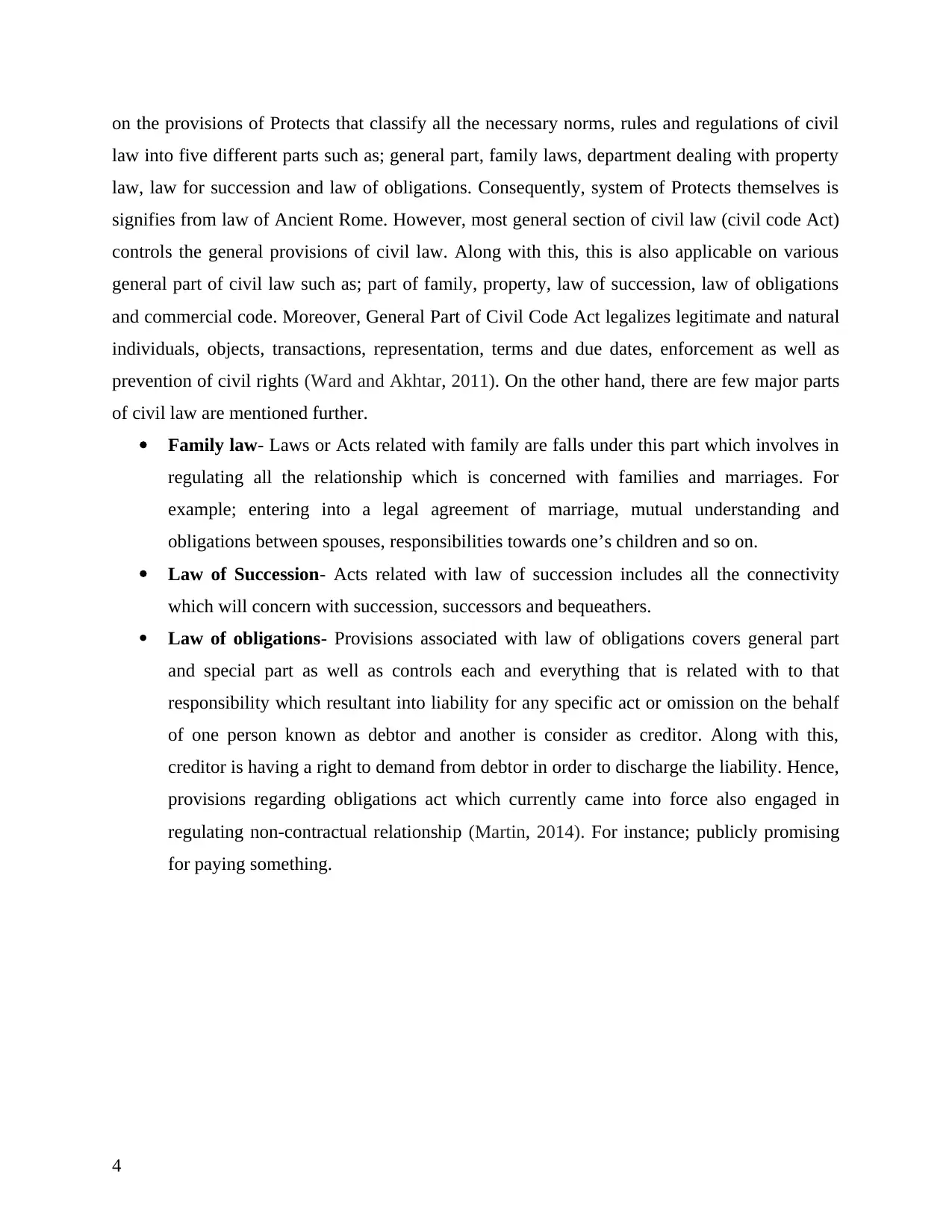
on the provisions of Protects that classify all the necessary norms, rules and regulations of civil
law into five different parts such as; general part, family laws, department dealing with property
law, law for succession and law of obligations. Consequently, system of Protects themselves is
signifies from law of Ancient Rome. However, most general section of civil law (civil code Act)
controls the general provisions of civil law. Along with this, this is also applicable on various
general part of civil law such as; part of family, property, law of succession, law of obligations
and commercial code. Moreover, General Part of Civil Code Act legalizes legitimate and natural
individuals, objects, transactions, representation, terms and due dates, enforcement as well as
prevention of civil rights (Ward and Akhtar, 2011). On the other hand, there are few major parts
of civil law are mentioned further.
Family law- Laws or Acts related with family are falls under this part which involves in
regulating all the relationship which is concerned with families and marriages. For
example; entering into a legal agreement of marriage, mutual understanding and
obligations between spouses, responsibilities towards one’s children and so on.
Law of Succession- Acts related with law of succession includes all the connectivity
which will concern with succession, successors and bequeathers.
Law of obligations- Provisions associated with law of obligations covers general part
and special part as well as controls each and everything that is related with to that
responsibility which resultant into liability for any specific act or omission on the behalf
of one person known as debtor and another is consider as creditor. Along with this,
creditor is having a right to demand from debtor in order to discharge the liability. Hence,
provisions regarding obligations act which currently came into force also engaged in
regulating non-contractual relationship (Martin, 2014). For instance; publicly promising
for paying something.
4
law into five different parts such as; general part, family laws, department dealing with property
law, law for succession and law of obligations. Consequently, system of Protects themselves is
signifies from law of Ancient Rome. However, most general section of civil law (civil code Act)
controls the general provisions of civil law. Along with this, this is also applicable on various
general part of civil law such as; part of family, property, law of succession, law of obligations
and commercial code. Moreover, General Part of Civil Code Act legalizes legitimate and natural
individuals, objects, transactions, representation, terms and due dates, enforcement as well as
prevention of civil rights (Ward and Akhtar, 2011). On the other hand, there are few major parts
of civil law are mentioned further.
Family law- Laws or Acts related with family are falls under this part which involves in
regulating all the relationship which is concerned with families and marriages. For
example; entering into a legal agreement of marriage, mutual understanding and
obligations between spouses, responsibilities towards one’s children and so on.
Law of Succession- Acts related with law of succession includes all the connectivity
which will concern with succession, successors and bequeathers.
Law of obligations- Provisions associated with law of obligations covers general part
and special part as well as controls each and everything that is related with to that
responsibility which resultant into liability for any specific act or omission on the behalf
of one person known as debtor and another is consider as creditor. Along with this,
creditor is having a right to demand from debtor in order to discharge the liability. Hence,
provisions regarding obligations act which currently came into force also engaged in
regulating non-contractual relationship (Martin, 2014). For instance; publicly promising
for paying something.
4
Secure Best Marks with AI Grader
Need help grading? Try our AI Grader for instant feedback on your assignments.
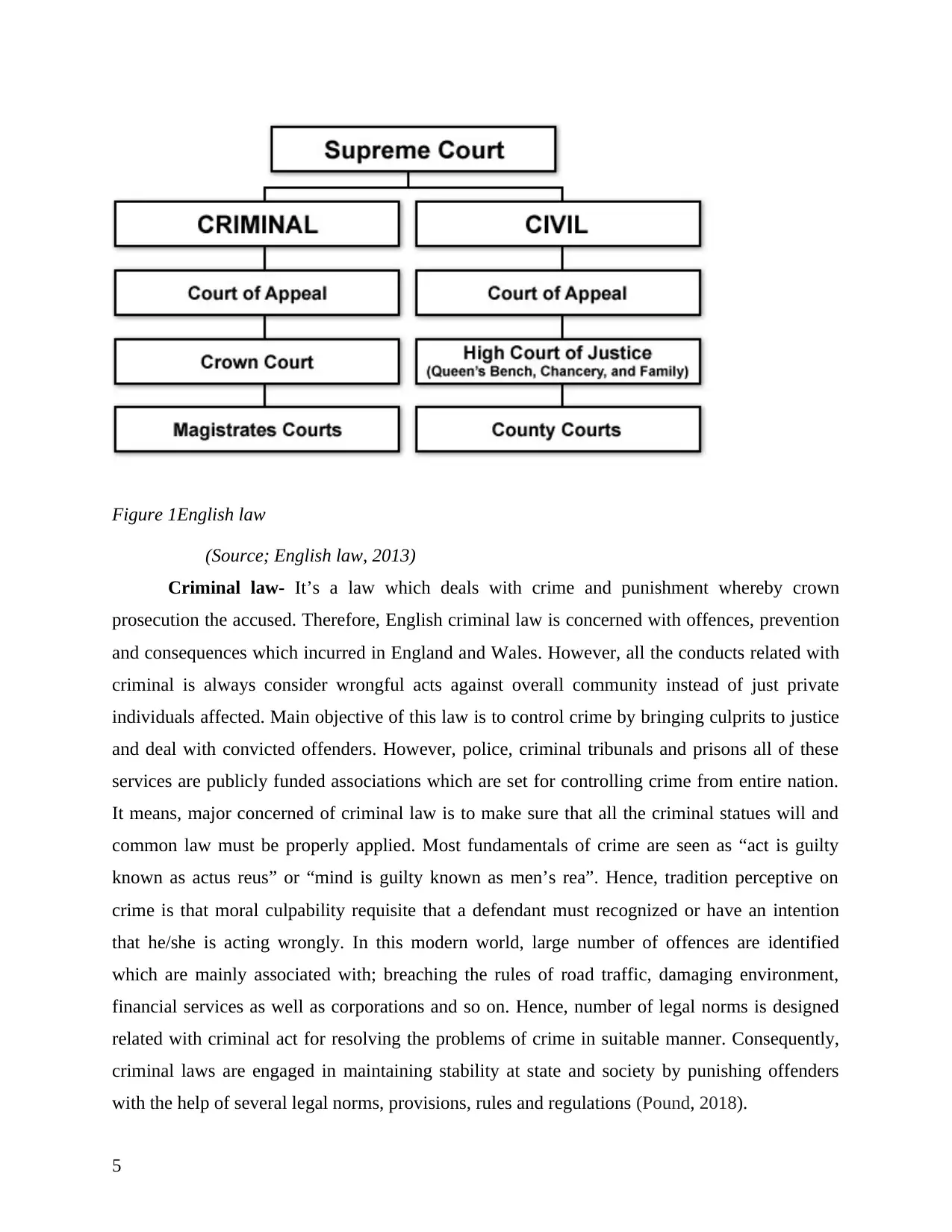
Figure 1English law
(Source; English law, 2013)
Criminal law- It’s a law which deals with crime and punishment whereby crown
prosecution the accused. Therefore, English criminal law is concerned with offences, prevention
and consequences which incurred in England and Wales. However, all the conducts related with
criminal is always consider wrongful acts against overall community instead of just private
individuals affected. Main objective of this law is to control crime by bringing culprits to justice
and deal with convicted offenders. However, police, criminal tribunals and prisons all of these
services are publicly funded associations which are set for controlling crime from entire nation.
It means, major concerned of criminal law is to make sure that all the criminal statues will and
common law must be properly applied. Most fundamentals of crime are seen as “act is guilty
known as actus reus” or “mind is guilty known as men’s rea”. Hence, tradition perceptive on
crime is that moral culpability requisite that a defendant must recognized or have an intention
that he/she is acting wrongly. In this modern world, large number of offences are identified
which are mainly associated with; breaching the rules of road traffic, damaging environment,
financial services as well as corporations and so on. Hence, number of legal norms is designed
related with criminal act for resolving the problems of crime in suitable manner. Consequently,
criminal laws are engaged in maintaining stability at state and society by punishing offenders
with the help of several legal norms, provisions, rules and regulations (Pound, 2018).
5
(Source; English law, 2013)
Criminal law- It’s a law which deals with crime and punishment whereby crown
prosecution the accused. Therefore, English criminal law is concerned with offences, prevention
and consequences which incurred in England and Wales. However, all the conducts related with
criminal is always consider wrongful acts against overall community instead of just private
individuals affected. Main objective of this law is to control crime by bringing culprits to justice
and deal with convicted offenders. However, police, criminal tribunals and prisons all of these
services are publicly funded associations which are set for controlling crime from entire nation.
It means, major concerned of criminal law is to make sure that all the criminal statues will and
common law must be properly applied. Most fundamentals of crime are seen as “act is guilty
known as actus reus” or “mind is guilty known as men’s rea”. Hence, tradition perceptive on
crime is that moral culpability requisite that a defendant must recognized or have an intention
that he/she is acting wrongly. In this modern world, large number of offences are identified
which are mainly associated with; breaching the rules of road traffic, damaging environment,
financial services as well as corporations and so on. Hence, number of legal norms is designed
related with criminal act for resolving the problems of crime in suitable manner. Consequently,
criminal laws are engaged in maintaining stability at state and society by punishing offenders
with the help of several legal norms, provisions, rules and regulations (Pound, 2018).
5
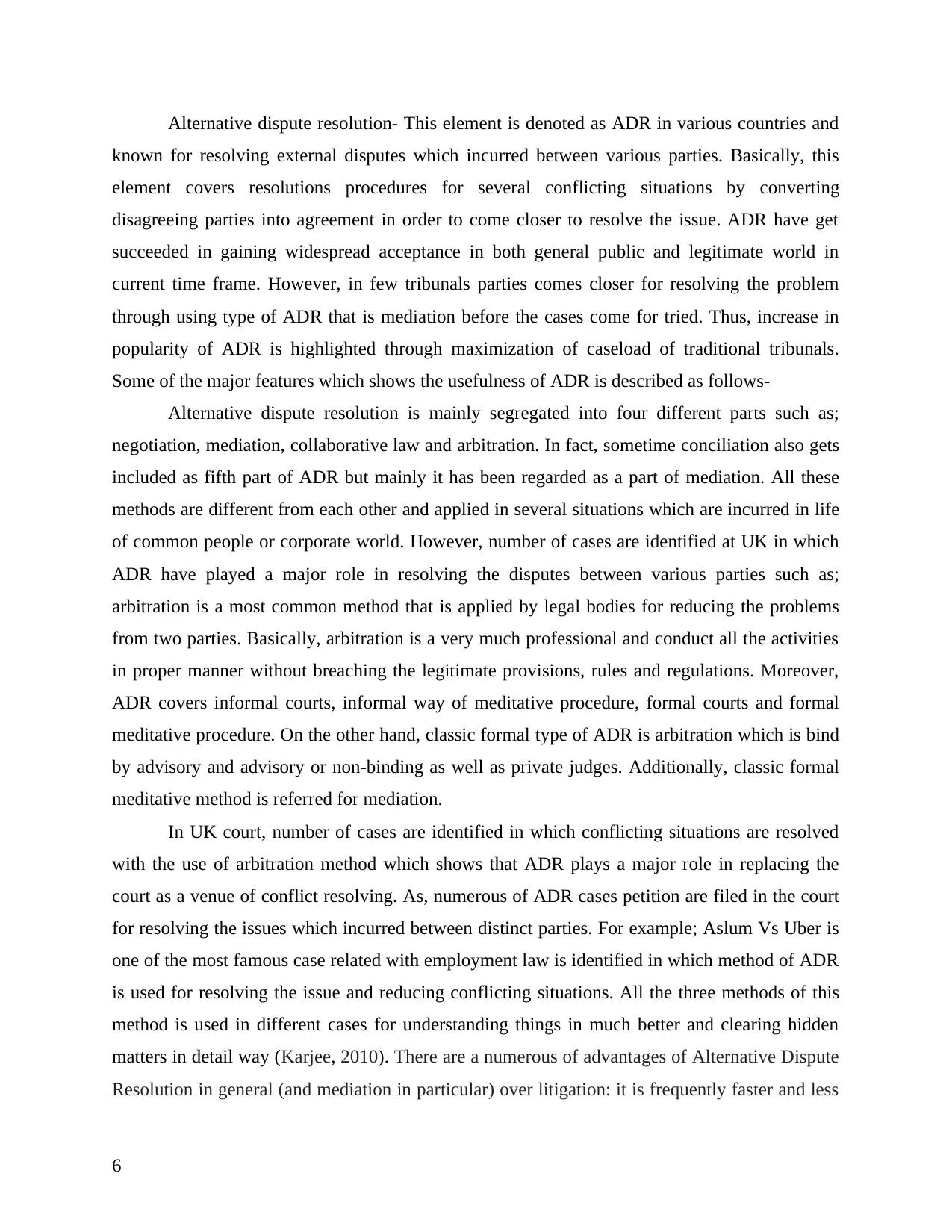
Alternative dispute resolution- This element is denoted as ADR in various countries and
known for resolving external disputes which incurred between various parties. Basically, this
element covers resolutions procedures for several conflicting situations by converting
disagreeing parties into agreement in order to come closer to resolve the issue. ADR have get
succeeded in gaining widespread acceptance in both general public and legitimate world in
current time frame. However, in few tribunals parties comes closer for resolving the problem
through using type of ADR that is mediation before the cases come for tried. Thus, increase in
popularity of ADR is highlighted through maximization of caseload of traditional tribunals.
Some of the major features which shows the usefulness of ADR is described as follows-
Alternative dispute resolution is mainly segregated into four different parts such as;
negotiation, mediation, collaborative law and arbitration. In fact, sometime conciliation also gets
included as fifth part of ADR but mainly it has been regarded as a part of mediation. All these
methods are different from each other and applied in several situations which are incurred in life
of common people or corporate world. However, number of cases are identified at UK in which
ADR have played a major role in resolving the disputes between various parties such as;
arbitration is a most common method that is applied by legal bodies for reducing the problems
from two parties. Basically, arbitration is a very much professional and conduct all the activities
in proper manner without breaching the legitimate provisions, rules and regulations. Moreover,
ADR covers informal courts, informal way of meditative procedure, formal courts and formal
meditative procedure. On the other hand, classic formal type of ADR is arbitration which is bind
by advisory and advisory or non-binding as well as private judges. Additionally, classic formal
meditative method is referred for mediation.
In UK court, number of cases are identified in which conflicting situations are resolved
with the use of arbitration method which shows that ADR plays a major role in replacing the
court as a venue of conflict resolving. As, numerous of ADR cases petition are filed in the court
for resolving the issues which incurred between distinct parties. For example; Aslum Vs Uber is
one of the most famous case related with employment law is identified in which method of ADR
is used for resolving the issue and reducing conflicting situations. All the three methods of this
method is used in different cases for understanding things in much better and clearing hidden
matters in detail way (Karjee, 2010). There are a numerous of advantages of Alternative Dispute
Resolution in general (and mediation in particular) over litigation: it is frequently faster and less
6
known for resolving external disputes which incurred between various parties. Basically, this
element covers resolutions procedures for several conflicting situations by converting
disagreeing parties into agreement in order to come closer to resolve the issue. ADR have get
succeeded in gaining widespread acceptance in both general public and legitimate world in
current time frame. However, in few tribunals parties comes closer for resolving the problem
through using type of ADR that is mediation before the cases come for tried. Thus, increase in
popularity of ADR is highlighted through maximization of caseload of traditional tribunals.
Some of the major features which shows the usefulness of ADR is described as follows-
Alternative dispute resolution is mainly segregated into four different parts such as;
negotiation, mediation, collaborative law and arbitration. In fact, sometime conciliation also gets
included as fifth part of ADR but mainly it has been regarded as a part of mediation. All these
methods are different from each other and applied in several situations which are incurred in life
of common people or corporate world. However, number of cases are identified at UK in which
ADR have played a major role in resolving the disputes between various parties such as;
arbitration is a most common method that is applied by legal bodies for reducing the problems
from two parties. Basically, arbitration is a very much professional and conduct all the activities
in proper manner without breaching the legitimate provisions, rules and regulations. Moreover,
ADR covers informal courts, informal way of meditative procedure, formal courts and formal
meditative procedure. On the other hand, classic formal type of ADR is arbitration which is bind
by advisory and advisory or non-binding as well as private judges. Additionally, classic formal
meditative method is referred for mediation.
In UK court, number of cases are identified in which conflicting situations are resolved
with the use of arbitration method which shows that ADR plays a major role in replacing the
court as a venue of conflict resolving. As, numerous of ADR cases petition are filed in the court
for resolving the issues which incurred between distinct parties. For example; Aslum Vs Uber is
one of the most famous case related with employment law is identified in which method of ADR
is used for resolving the issue and reducing conflicting situations. All the three methods of this
method is used in different cases for understanding things in much better and clearing hidden
matters in detail way (Karjee, 2010). There are a numerous of advantages of Alternative Dispute
Resolution in general (and mediation in particular) over litigation: it is frequently faster and less
6
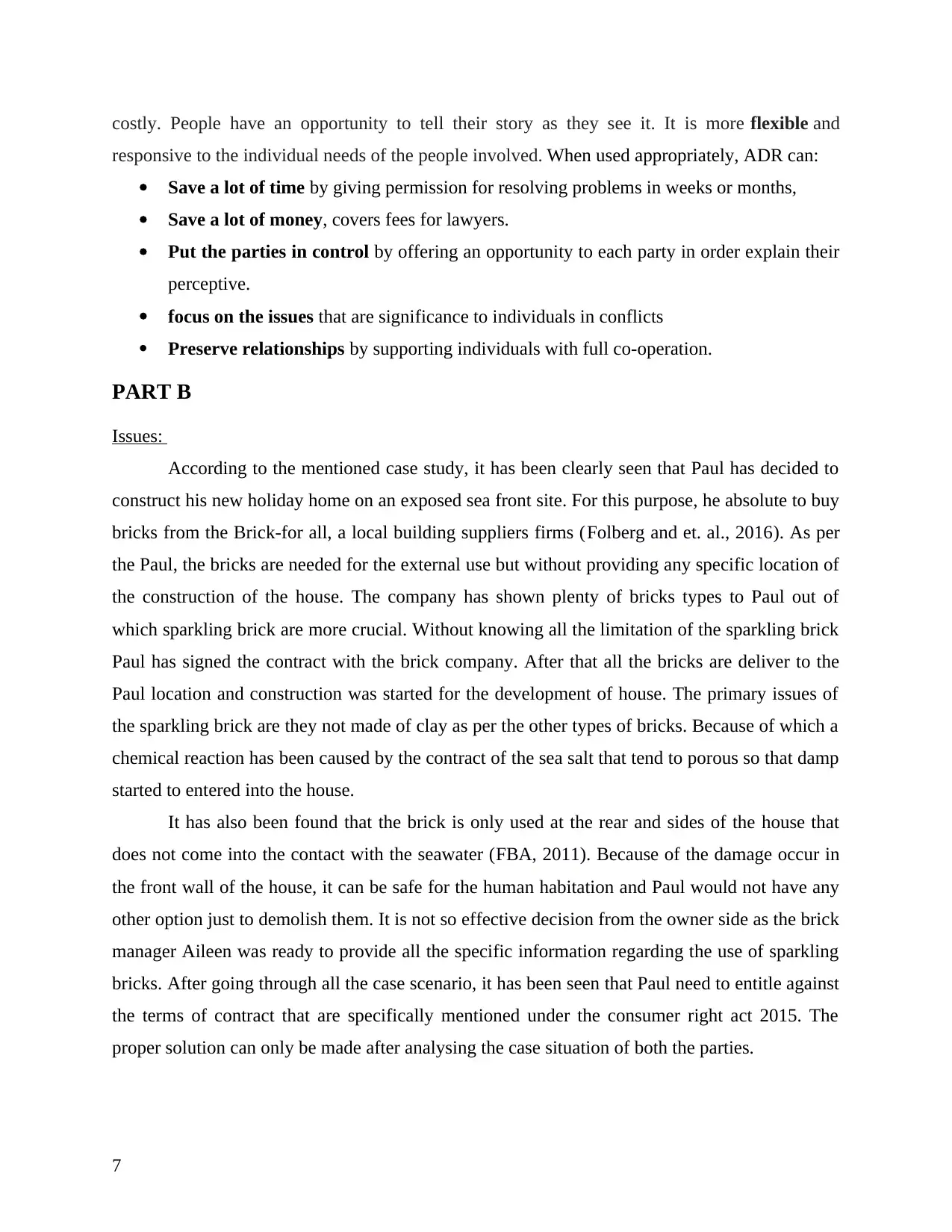
costly. People have an opportunity to tell their story as they see it. It is more flexible and
responsive to the individual needs of the people involved. When used appropriately, ADR can:
Save a lot of time by giving permission for resolving problems in weeks or months,
Save a lot of money, covers fees for lawyers.
Put the parties in control by offering an opportunity to each party in order explain their
perceptive.
focus on the issues that are significance to individuals in conflicts
Preserve relationships by supporting individuals with full co-operation.
PART B
Issues:
According to the mentioned case study, it has been clearly seen that Paul has decided to
construct his new holiday home on an exposed sea front site. For this purpose, he absolute to buy
bricks from the Brick-for all, a local building suppliers firms (Folberg and et. al., 2016). As per
the Paul, the bricks are needed for the external use but without providing any specific location of
the construction of the house. The company has shown plenty of bricks types to Paul out of
which sparkling brick are more crucial. Without knowing all the limitation of the sparkling brick
Paul has signed the contract with the brick company. After that all the bricks are deliver to the
Paul location and construction was started for the development of house. The primary issues of
the sparkling brick are they not made of clay as per the other types of bricks. Because of which a
chemical reaction has been caused by the contract of the sea salt that tend to porous so that damp
started to entered into the house.
It has also been found that the brick is only used at the rear and sides of the house that
does not come into the contact with the seawater (FBA, 2011). Because of the damage occur in
the front wall of the house, it can be safe for the human habitation and Paul would not have any
other option just to demolish them. It is not so effective decision from the owner side as the brick
manager Aileen was ready to provide all the specific information regarding the use of sparkling
bricks. After going through all the case scenario, it has been seen that Paul need to entitle against
the terms of contract that are specifically mentioned under the consumer right act 2015. The
proper solution can only be made after analysing the case situation of both the parties.
7
responsive to the individual needs of the people involved. When used appropriately, ADR can:
Save a lot of time by giving permission for resolving problems in weeks or months,
Save a lot of money, covers fees for lawyers.
Put the parties in control by offering an opportunity to each party in order explain their
perceptive.
focus on the issues that are significance to individuals in conflicts
Preserve relationships by supporting individuals with full co-operation.
PART B
Issues:
According to the mentioned case study, it has been clearly seen that Paul has decided to
construct his new holiday home on an exposed sea front site. For this purpose, he absolute to buy
bricks from the Brick-for all, a local building suppliers firms (Folberg and et. al., 2016). As per
the Paul, the bricks are needed for the external use but without providing any specific location of
the construction of the house. The company has shown plenty of bricks types to Paul out of
which sparkling brick are more crucial. Without knowing all the limitation of the sparkling brick
Paul has signed the contract with the brick company. After that all the bricks are deliver to the
Paul location and construction was started for the development of house. The primary issues of
the sparkling brick are they not made of clay as per the other types of bricks. Because of which a
chemical reaction has been caused by the contract of the sea salt that tend to porous so that damp
started to entered into the house.
It has also been found that the brick is only used at the rear and sides of the house that
does not come into the contact with the seawater (FBA, 2011). Because of the damage occur in
the front wall of the house, it can be safe for the human habitation and Paul would not have any
other option just to demolish them. It is not so effective decision from the owner side as the brick
manager Aileen was ready to provide all the specific information regarding the use of sparkling
bricks. After going through all the case scenario, it has been seen that Paul need to entitle against
the terms of contract that are specifically mentioned under the consumer right act 2015. The
proper solution can only be made after analysing the case situation of both the parties.
7
Paraphrase This Document
Need a fresh take? Get an instant paraphrase of this document with our AI Paraphraser
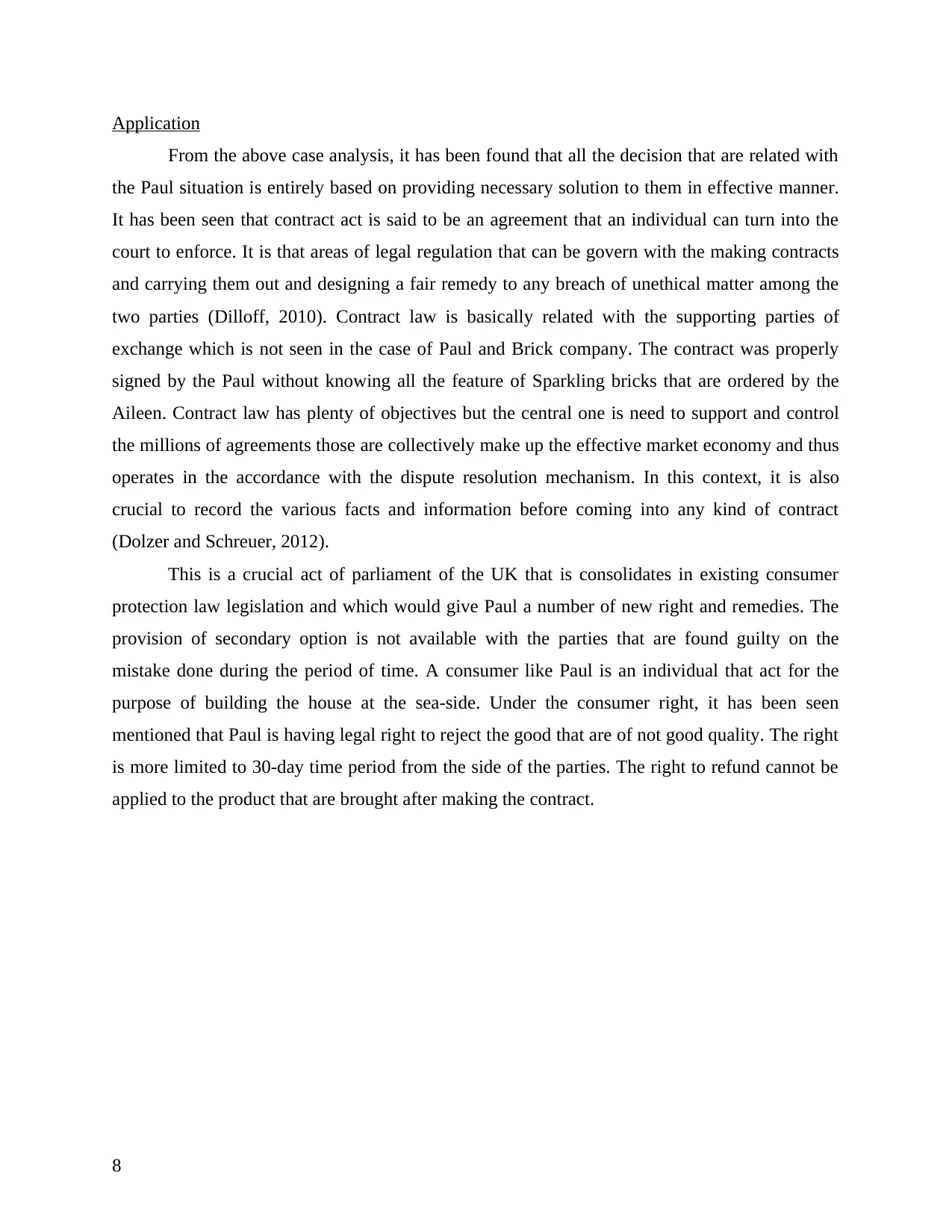
Application
From the above case analysis, it has been found that all the decision that are related with
the Paul situation is entirely based on providing necessary solution to them in effective manner.
It has been seen that contract act is said to be an agreement that an individual can turn into the
court to enforce. It is that areas of legal regulation that can be govern with the making contracts
and carrying them out and designing a fair remedy to any breach of unethical matter among the
two parties (Dilloff, 2010). Contract law is basically related with the supporting parties of
exchange which is not seen in the case of Paul and Brick company. The contract was properly
signed by the Paul without knowing all the feature of Sparkling bricks that are ordered by the
Aileen. Contract law has plenty of objectives but the central one is need to support and control
the millions of agreements those are collectively make up the effective market economy and thus
operates in the accordance with the dispute resolution mechanism. In this context, it is also
crucial to record the various facts and information before coming into any kind of contract
(Dolzer and Schreuer, 2012).
This is a crucial act of parliament of the UK that is consolidates in existing consumer
protection law legislation and which would give Paul a number of new right and remedies. The
provision of secondary option is not available with the parties that are found guilty on the
mistake done during the period of time. A consumer like Paul is an individual that act for the
purpose of building the house at the sea-side. Under the consumer right, it has been seen
mentioned that Paul is having legal right to reject the good that are of not good quality. The right
is more limited to 30-day time period from the side of the parties. The right to refund cannot be
applied to the product that are brought after making the contract.
8
From the above case analysis, it has been found that all the decision that are related with
the Paul situation is entirely based on providing necessary solution to them in effective manner.
It has been seen that contract act is said to be an agreement that an individual can turn into the
court to enforce. It is that areas of legal regulation that can be govern with the making contracts
and carrying them out and designing a fair remedy to any breach of unethical matter among the
two parties (Dilloff, 2010). Contract law is basically related with the supporting parties of
exchange which is not seen in the case of Paul and Brick company. The contract was properly
signed by the Paul without knowing all the feature of Sparkling bricks that are ordered by the
Aileen. Contract law has plenty of objectives but the central one is need to support and control
the millions of agreements those are collectively make up the effective market economy and thus
operates in the accordance with the dispute resolution mechanism. In this context, it is also
crucial to record the various facts and information before coming into any kind of contract
(Dolzer and Schreuer, 2012).
This is a crucial act of parliament of the UK that is consolidates in existing consumer
protection law legislation and which would give Paul a number of new right and remedies. The
provision of secondary option is not available with the parties that are found guilty on the
mistake done during the period of time. A consumer like Paul is an individual that act for the
purpose of building the house at the sea-side. Under the consumer right, it has been seen
mentioned that Paul is having legal right to reject the good that are of not good quality. The right
is more limited to 30-day time period from the side of the parties. The right to refund cannot be
applied to the product that are brought after making the contract.
8
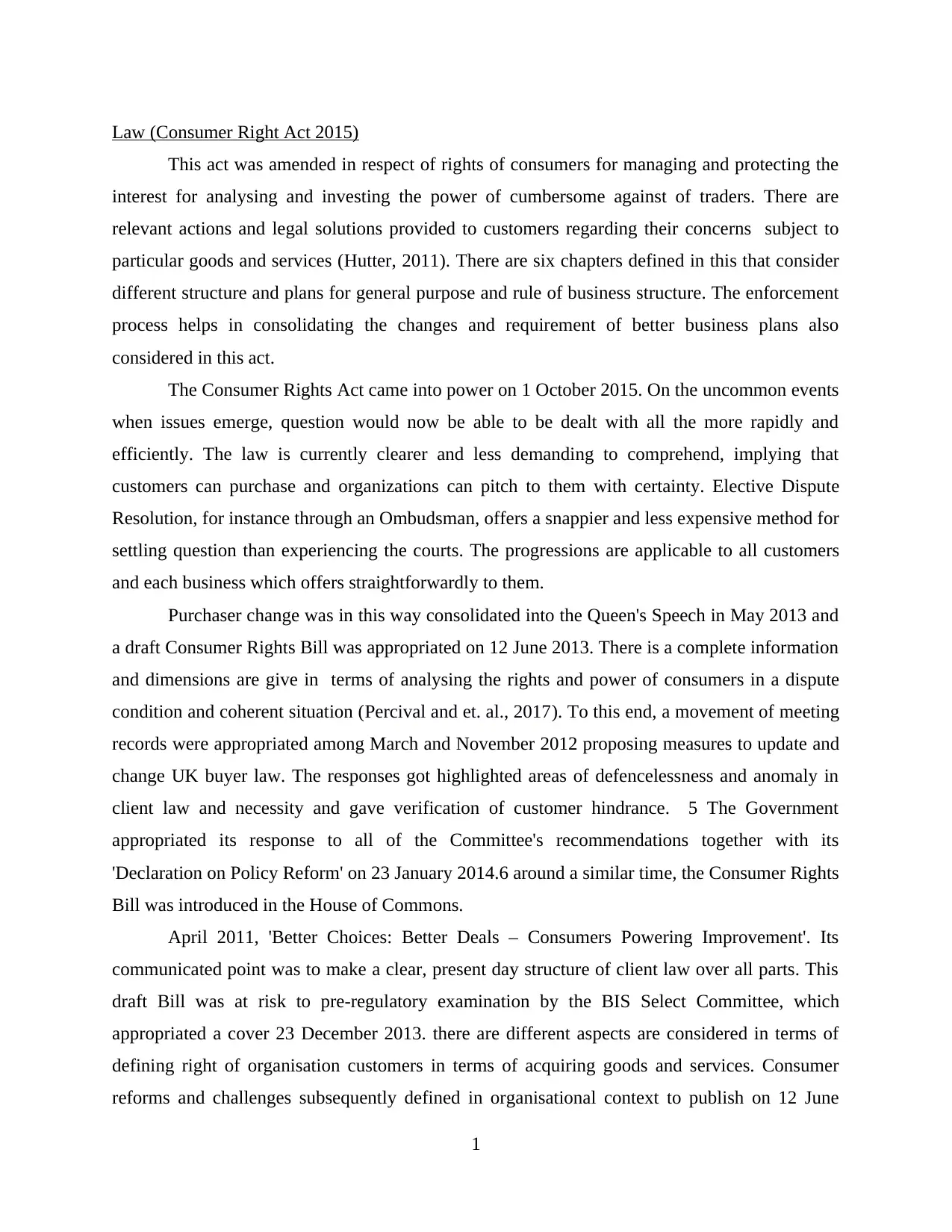
Law (Consumer Right Act 2015)
This act was amended in respect of rights of consumers for managing and protecting the
interest for analysing and investing the power of cumbersome against of traders. There are
relevant actions and legal solutions provided to customers regarding their concerns subject to
particular goods and services (Hutter, 2011). There are six chapters defined in this that consider
different structure and plans for general purpose and rule of business structure. The enforcement
process helps in consolidating the changes and requirement of better business plans also
considered in this act.
The Consumer Rights Act came into power on 1 October 2015. On the uncommon events
when issues emerge, question would now be able to be dealt with all the more rapidly and
efficiently. The law is currently clearer and less demanding to comprehend, implying that
customers can purchase and organizations can pitch to them with certainty. Elective Dispute
Resolution, for instance through an Ombudsman, offers a snappier and less expensive method for
settling question than experiencing the courts. The progressions are applicable to all customers
and each business which offers straightforwardly to them.
Purchaser change was in this way consolidated into the Queen's Speech in May 2013 and
a draft Consumer Rights Bill was appropriated on 12 June 2013. There is a complete information
and dimensions are give in terms of analysing the rights and power of consumers in a dispute
condition and coherent situation (Percival and et. al., 2017). To this end, a movement of meeting
records were appropriated among March and November 2012 proposing measures to update and
change UK buyer law. The responses got highlighted areas of defencelessness and anomaly in
client law and necessity and gave verification of customer hindrance. 5 The Government
appropriated its response to all of the Committee's recommendations together with its
'Declaration on Policy Reform' on 23 January 2014.6 around a similar time, the Consumer Rights
Bill was introduced in the House of Commons.
April 2011, 'Better Choices: Better Deals – Consumers Powering Improvement'. Its
communicated point was to make a clear, present day structure of client law over all parts. This
draft Bill was at risk to pre-regulatory examination by the BIS Select Committee, which
appropriated a cover 23 December 2013. there are different aspects are considered in terms of
defining right of organisation customers in terms of acquiring goods and services. Consumer
reforms and challenges subsequently defined in organisational context to publish on 12 June
1
This act was amended in respect of rights of consumers for managing and protecting the
interest for analysing and investing the power of cumbersome against of traders. There are
relevant actions and legal solutions provided to customers regarding their concerns subject to
particular goods and services (Hutter, 2011). There are six chapters defined in this that consider
different structure and plans for general purpose and rule of business structure. The enforcement
process helps in consolidating the changes and requirement of better business plans also
considered in this act.
The Consumer Rights Act came into power on 1 October 2015. On the uncommon events
when issues emerge, question would now be able to be dealt with all the more rapidly and
efficiently. The law is currently clearer and less demanding to comprehend, implying that
customers can purchase and organizations can pitch to them with certainty. Elective Dispute
Resolution, for instance through an Ombudsman, offers a snappier and less expensive method for
settling question than experiencing the courts. The progressions are applicable to all customers
and each business which offers straightforwardly to them.
Purchaser change was in this way consolidated into the Queen's Speech in May 2013 and
a draft Consumer Rights Bill was appropriated on 12 June 2013. There is a complete information
and dimensions are give in terms of analysing the rights and power of consumers in a dispute
condition and coherent situation (Percival and et. al., 2017). To this end, a movement of meeting
records were appropriated among March and November 2012 proposing measures to update and
change UK buyer law. The responses got highlighted areas of defencelessness and anomaly in
client law and necessity and gave verification of customer hindrance. 5 The Government
appropriated its response to all of the Committee's recommendations together with its
'Declaration on Policy Reform' on 23 January 2014.6 around a similar time, the Consumer Rights
Bill was introduced in the House of Commons.
April 2011, 'Better Choices: Better Deals – Consumers Powering Improvement'. Its
communicated point was to make a clear, present day structure of client law over all parts. This
draft Bill was at risk to pre-regulatory examination by the BIS Select Committee, which
appropriated a cover 23 December 2013. there are different aspects are considered in terms of
defining right of organisation customers in terms of acquiring goods and services. Consumer
reforms and challenges subsequently defined in organisational context to publish on 12 June
1
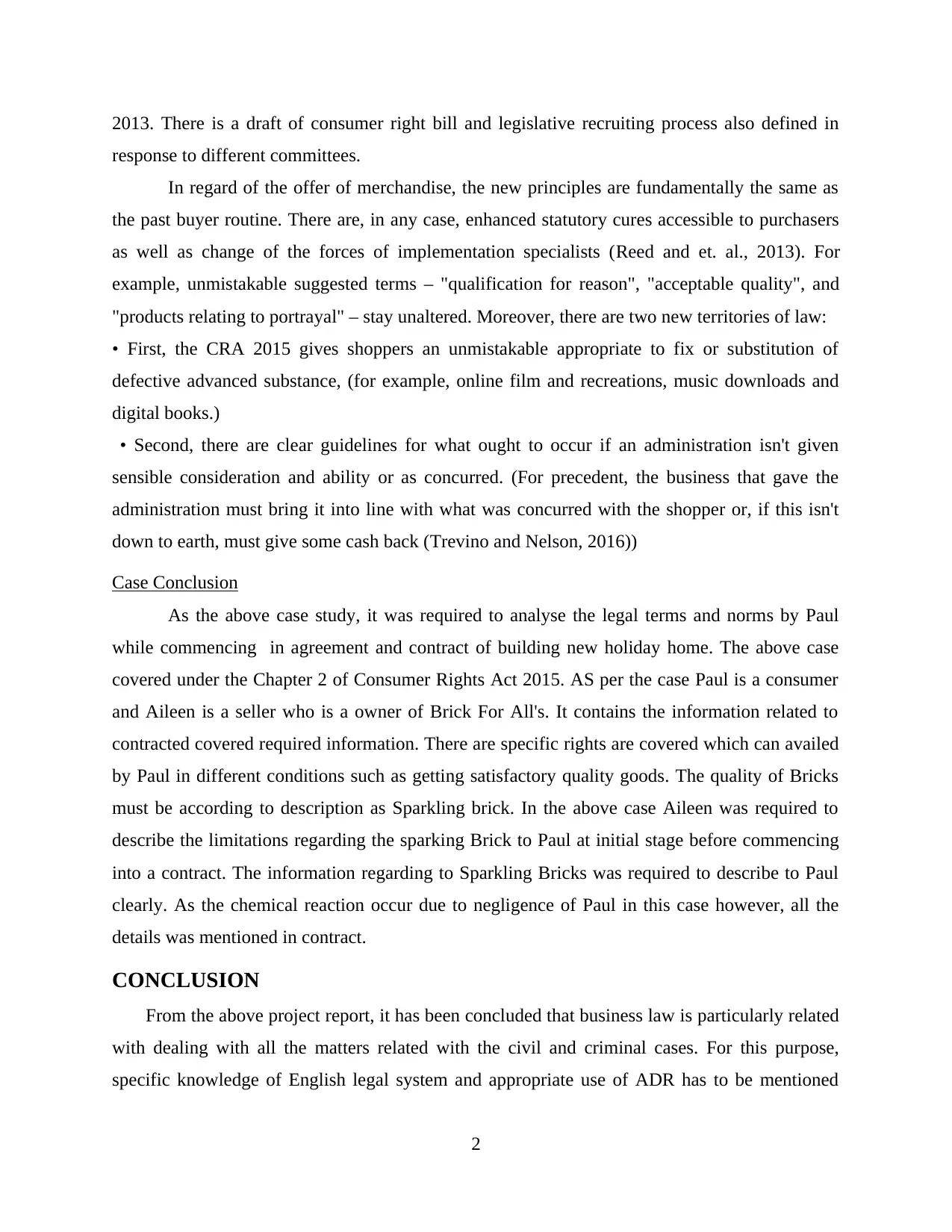
2013. There is a draft of consumer right bill and legislative recruiting process also defined in
response to different committees.
In regard of the offer of merchandise, the new principles are fundamentally the same as
the past buyer routine. There are, in any case, enhanced statutory cures accessible to purchasers
as well as change of the forces of implementation specialists (Reed and et. al., 2013). For
example, unmistakable suggested terms – "qualification for reason", "acceptable quality", and
"products relating to portrayal" – stay unaltered. Moreover, there are two new territories of law:
• First, the CRA 2015 gives shoppers an unmistakable appropriate to fix or substitution of
defective advanced substance, (for example, online film and recreations, music downloads and
digital books.)
• Second, there are clear guidelines for what ought to occur if an administration isn't given
sensible consideration and ability or as concurred. (For precedent, the business that gave the
administration must bring it into line with what was concurred with the shopper or, if this isn't
down to earth, must give some cash back (Trevino and Nelson, 2016))
Case Conclusion
As the above case study, it was required to analyse the legal terms and norms by Paul
while commencing in agreement and contract of building new holiday home. The above case
covered under the Chapter 2 of Consumer Rights Act 2015. AS per the case Paul is a consumer
and Aileen is a seller who is a owner of Brick For All's. It contains the information related to
contracted covered required information. There are specific rights are covered which can availed
by Paul in different conditions such as getting satisfactory quality goods. The quality of Bricks
must be according to description as Sparkling brick. In the above case Aileen was required to
describe the limitations regarding the sparking Brick to Paul at initial stage before commencing
into a contract. The information regarding to Sparkling Bricks was required to describe to Paul
clearly. As the chemical reaction occur due to negligence of Paul in this case however, all the
details was mentioned in contract.
CONCLUSION
From the above project report, it has been concluded that business law is particularly related
with dealing with all the matters related with the civil and criminal cases. For this purpose,
specific knowledge of English legal system and appropriate use of ADR has to be mentioned
2
response to different committees.
In regard of the offer of merchandise, the new principles are fundamentally the same as
the past buyer routine. There are, in any case, enhanced statutory cures accessible to purchasers
as well as change of the forces of implementation specialists (Reed and et. al., 2013). For
example, unmistakable suggested terms – "qualification for reason", "acceptable quality", and
"products relating to portrayal" – stay unaltered. Moreover, there are two new territories of law:
• First, the CRA 2015 gives shoppers an unmistakable appropriate to fix or substitution of
defective advanced substance, (for example, online film and recreations, music downloads and
digital books.)
• Second, there are clear guidelines for what ought to occur if an administration isn't given
sensible consideration and ability or as concurred. (For precedent, the business that gave the
administration must bring it into line with what was concurred with the shopper or, if this isn't
down to earth, must give some cash back (Trevino and Nelson, 2016))
Case Conclusion
As the above case study, it was required to analyse the legal terms and norms by Paul
while commencing in agreement and contract of building new holiday home. The above case
covered under the Chapter 2 of Consumer Rights Act 2015. AS per the case Paul is a consumer
and Aileen is a seller who is a owner of Brick For All's. It contains the information related to
contracted covered required information. There are specific rights are covered which can availed
by Paul in different conditions such as getting satisfactory quality goods. The quality of Bricks
must be according to description as Sparkling brick. In the above case Aileen was required to
describe the limitations regarding the sparking Brick to Paul at initial stage before commencing
into a contract. The information regarding to Sparkling Bricks was required to describe to Paul
clearly. As the chemical reaction occur due to negligence of Paul in this case however, all the
details was mentioned in contract.
CONCLUSION
From the above project report, it has been concluded that business law is particularly related
with dealing with all the matters related with the civil and criminal cases. For this purpose,
specific knowledge of English legal system and appropriate use of ADR has to be mentioned
2
Secure Best Marks with AI Grader
Need help grading? Try our AI Grader for instant feedback on your assignments.

clearly in the report. The analysis of the case has also been discussed to reached at the certain
point in the coming period of time.
3
point in the coming period of time.
3
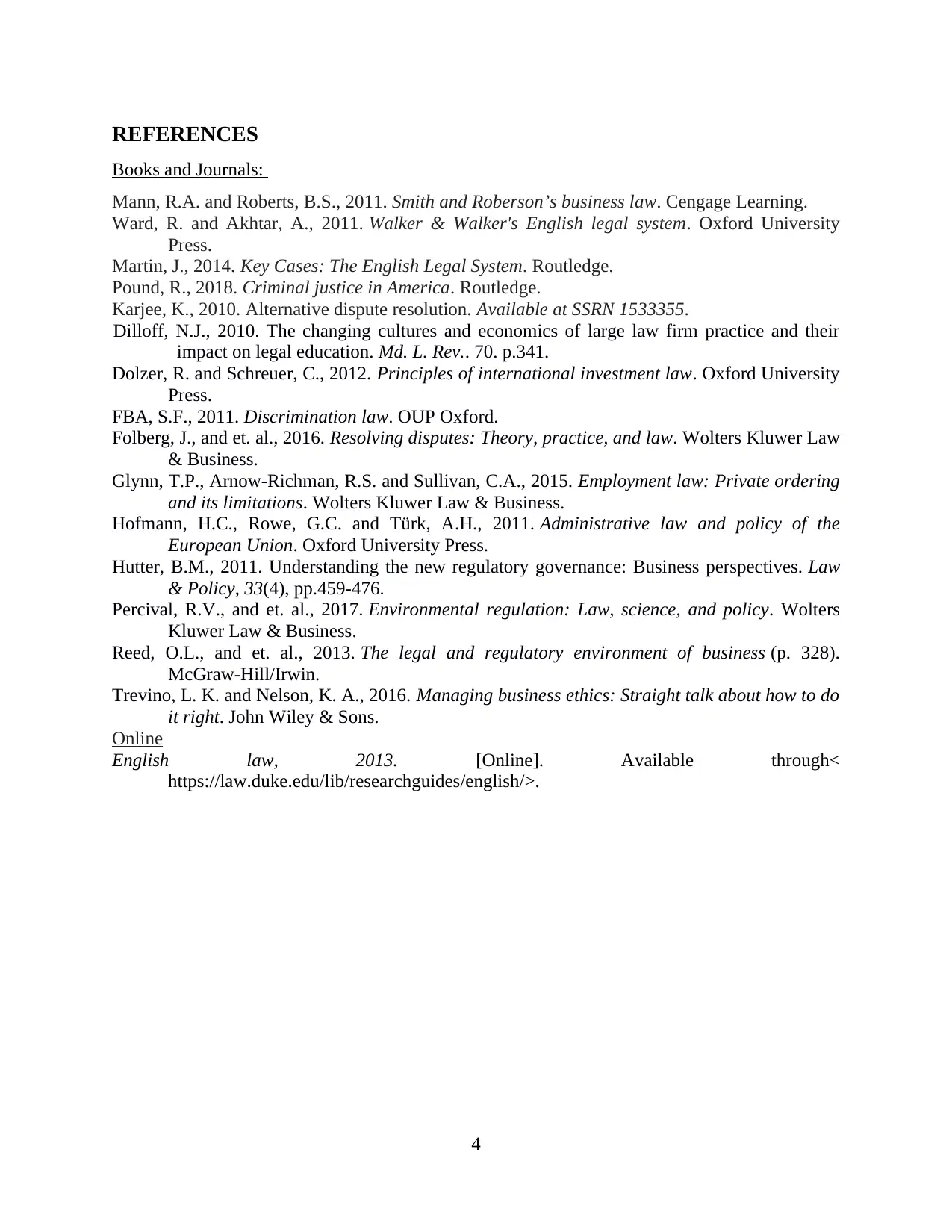
REFERENCES
Books and Journals:
Mann, R.A. and Roberts, B.S., 2011. Smith and Roberson’s business law. Cengage Learning.
Ward, R. and Akhtar, A., 2011. Walker & Walker's English legal system. Oxford University
Press.
Martin, J., 2014. Key Cases: The English Legal System. Routledge.
Pound, R., 2018. Criminal justice in America. Routledge.
Karjee, K., 2010. Alternative dispute resolution. Available at SSRN 1533355.
Dilloff, N.J., 2010. The changing cultures and economics of large law firm practice and their
impact on legal education. Md. L. Rev.. 70. p.341.
Dolzer, R. and Schreuer, C., 2012. Principles of international investment law. Oxford University
Press.
FBA, S.F., 2011. Discrimination law. OUP Oxford.
Folberg, J., and et. al., 2016. Resolving disputes: Theory, practice, and law. Wolters Kluwer Law
& Business.
Glynn, T.P., Arnow-Richman, R.S. and Sullivan, C.A., 2015. Employment law: Private ordering
and its limitations. Wolters Kluwer Law & Business.
Hofmann, H.C., Rowe, G.C. and Türk, A.H., 2011. Administrative law and policy of the
European Union. Oxford University Press.
Hutter, B.M., 2011. Understanding the new regulatory governance: Business perspectives. Law
& Policy, 33(4), pp.459-476.
Percival, R.V., and et. al., 2017. Environmental regulation: Law, science, and policy. Wolters
Kluwer Law & Business.
Reed, O.L., and et. al., 2013. The legal and regulatory environment of business (p. 328).
McGraw-Hill/Irwin.
Trevino, L. K. and Nelson, K. A., 2016. Managing business ethics: Straight talk about how to do
it right. John Wiley & Sons.
Online
English law, 2013. [Online]. Available through<
https://law.duke.edu/lib/researchguides/english/>.
4
Books and Journals:
Mann, R.A. and Roberts, B.S., 2011. Smith and Roberson’s business law. Cengage Learning.
Ward, R. and Akhtar, A., 2011. Walker & Walker's English legal system. Oxford University
Press.
Martin, J., 2014. Key Cases: The English Legal System. Routledge.
Pound, R., 2018. Criminal justice in America. Routledge.
Karjee, K., 2010. Alternative dispute resolution. Available at SSRN 1533355.
Dilloff, N.J., 2010. The changing cultures and economics of large law firm practice and their
impact on legal education. Md. L. Rev.. 70. p.341.
Dolzer, R. and Schreuer, C., 2012. Principles of international investment law. Oxford University
Press.
FBA, S.F., 2011. Discrimination law. OUP Oxford.
Folberg, J., and et. al., 2016. Resolving disputes: Theory, practice, and law. Wolters Kluwer Law
& Business.
Glynn, T.P., Arnow-Richman, R.S. and Sullivan, C.A., 2015. Employment law: Private ordering
and its limitations. Wolters Kluwer Law & Business.
Hofmann, H.C., Rowe, G.C. and Türk, A.H., 2011. Administrative law and policy of the
European Union. Oxford University Press.
Hutter, B.M., 2011. Understanding the new regulatory governance: Business perspectives. Law
& Policy, 33(4), pp.459-476.
Percival, R.V., and et. al., 2017. Environmental regulation: Law, science, and policy. Wolters
Kluwer Law & Business.
Reed, O.L., and et. al., 2013. The legal and regulatory environment of business (p. 328).
McGraw-Hill/Irwin.
Trevino, L. K. and Nelson, K. A., 2016. Managing business ethics: Straight talk about how to do
it right. John Wiley & Sons.
Online
English law, 2013. [Online]. Available through<
https://law.duke.edu/lib/researchguides/english/>.
4

5
Paraphrase This Document
Need a fresh take? Get an instant paraphrase of this document with our AI Paraphraser

6
1 out of 14
Related Documents
Your All-in-One AI-Powered Toolkit for Academic Success.
+13062052269
info@desklib.com
Available 24*7 on WhatsApp / Email
![[object Object]](/_next/static/media/star-bottom.7253800d.svg)
Unlock your academic potential
© 2024 | Zucol Services PVT LTD | All rights reserved.




